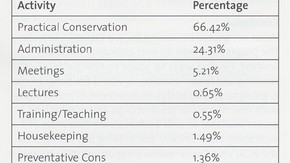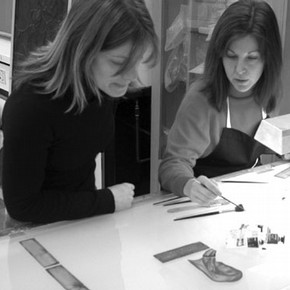Conservation Journal
Summer 2004 Issue 47
Future challenges for RCA/V&A conservation
The RCA/V&A Conservation 1 Masters' programme is unique. It is a fully validated postgraduate course taught entirely within the museum context. However, our very uniqueness is our Achilles heel. We are vulnerable to changes in our surroundings. So, as for any species experiencing changes in its environment - some subtle, some more drastic - our ability to adapt is the key. Such challenges can push us to develop and provide more effective education for future conservators.
Historical context
Since 1989, RCA/V&A Conservation has been providing MA studentships in specialist areas of conservation. These have been focussed primarily on the decorative arts where there was a perceived need for postgraduate training 2 . The studentships were normally three years, with a two-year fast-track for candidates who met our criteria in terms of conservation experience. The aim was for students to leave with a sound academic grounding in conservation generally, as well as in a specialised discipline, combined with a very high level of practical skill. Because each student has a place in a studio for the duration of the course, and a supervisor who is a senior conservator in that studio, places are normally limited to one student per studio and consequently one student per subject discipline for the duration of the course.
The V&A, the partner institution with the RCA, hosted the studentships, starting with two in 1989. Gradually, other museums and heritage bodies were invited to collaborate in disciplines which could not be offered at the V&A. The Museum of London, The Horniman Museum, The British Museum, Tate, and The National Trust were among those who became involved. Nevertheless, the programme, by its nature, remained small. Today this model of conservation education is being challenged in a number of ways.
The Challenges
The national museums present a very different picture than they did fifteen years ago when the course began. Shifting expectations of museums by government and society has led to radical changes. Museums are now seen by government as a tool of social policy. Department for Culture, Media and Sport funding is linked to demonstrating value using measurable outcomes and performance targets within defined criteria, such as access, learning, excellence, inclusion, efficiency and effectiveness. In addition, the availability of heritage lottery funding has focussed activity around capital expenditure projects on an undreamed of scale.
At the V&A, for example, wider public access to collections has been enabled through funding of major projects, such as the hugely successful British Galleries. These projects have had a direct impact on the working patterns of conservators. As a result of being involved in major projects more conservators than ever before have had to become all-round museum professionals: members of teams, working in flexible networks, using interpersonal skills in a range of out-of-studio activities. The project culture is also breaking down interdepartmental barriers, as teams are being formed and re-formed, new organisational systems set up, and networks evolved. The public-private interface grows ever more complex. In order to provide the necessary resources for projects private contractors are employed on short-term contracts in museums, and museum conservators write specifications for and managethe work of private contractors.
At the V&A, there is a new emphasis on flexibility. Future conservation posts will contain an expectation that post-holders will work across certain materials and object types. One of the aims here is to encourage the breaking down of barriers and sharing of knowledge and skills between specialisms. This changing employment pattern suggests lines along which we can develop our studentships.

Table 1. Conservation Department: Percentages of time Spent by Activity. (click image for larger version)
Conservators have a key role in preparing large numbers of objects for major projects. However, this kind of work has brought its own set of challenges. For British Galleries very careful records were kept of how time was spent by a group of conservators in the Conservation Department. The headings for 'lectures' and 'training/teaching' account for just over one percent of time spent. Further research is needed but this evidence suggests a downturn when compared with the early 1990s. Then a sliding scale of "research" time was allocated according to grade, starting with the lowest at 5%. Such changes will inevitably challenge our thinking about student numbers and the kinds of educational experiences we can offer. (Table 1. Figures from British Galleries Time Sheets; compiled by Timothy Carpenter)
These changes are set against a background of resources which appear to be static or even decreasing. The National Museums Directors' Conference (NMDC) has highlighted 'that NMDC members have received only modest grant-in-aid increases during the last five years … and yet the Government requires museums and galleries to further increase productivity as demonstrated in the targets it sets. It questions how far NMDC members can continue to deliver effectively against this background.' 3
Adapting to change
One way to approach adapting to these changes is to re-examine the basic model on which most studentships have been based to date - that of the specialised discipline, taught through a combination of supervised work experience gained within a specialist studio/laboratory and academic study.
In the light of developments at the V&A, for example, and in the profession as a whole, we are considering alternatives to the single specialism - a broader grouping along the lines of the North American 'object conservation'. Currently, we are recruiting for a student in 'Metalwork and other Materials'. This offers the opportunity to work across disciplines and studios, and to share the expertise of different staff. It can also offer development opportunities to staff as well as students.
Another approach is to broaden the context in which we work. This year we took on our first student in Natural History Collections. In collaboration with the Natural History Museum we have devised a new model which reflects the structure of the subject of natural history, of natural history conservation, and of the Natural History Museum itself. Students are based within the Palaeontology Conservation Unit but work across the five science departments (Botany, Entomology, Mineralogy, Palaeontology and Zoology) and the Department of Library and Information Services. This approach recognises the diversity of skills and knowledge required in a broader field and one where decisions on the conservation and preservation of objects often requires a wider perspective than that focussed on a single object.
Recently, we have also developed a new model for two-year studentships with a view to strengthening our curriculum, encouraging thinking, and to remove the disparities arising from running a two-and three-year MA. However, adapting to change successfully also involves finding ways of maintaining and preferably increasing the present number of MA students. To do so we are now expanding our horizons beyond the London area, and are discussing with potential collaborating institutions how a longer distance studentship might work.
Another way of increasing numbers is to broaden access to different audiences. One idea is to separate the theoretical teaching from the practical teaching in such a way as to provide a discreet course which could be attended by larger numbers. This suggestion was made at the same time as we were putting greater emphasis than ever before on the link between practical and theoretical which had always been a cornerstone of our philosophy. It is for this reason that we have rejected this idea, believing that our full resources should be going into providing the thing that is unique about our programme - teaching and learning within the profession.
We could also meet the challenge for wider access by providing more flexible ways of learning by offering part-time arrangements allowing students to carry on working while they study. We have been thinking about this in terms of professional development; for example, an employed conservator might wish to earn a MA while continuing to work.
Creating a modular course, which could be picked up at various points by students, could be another way of introducing more flexible learning. This could work for the theoretical part of the programme, but might undermine the link with studio practice. A system of credits along the lines of American universities, in which you could opt in or out of a module depending on your experience, is an option, but difficult to manage with small numbers of students working on real projects in a real environment.
Web-based learning is an obvious way of broadening access. We were the first Department in the RCA to have our own intranet site from which students and staff can download course information, such as timetables, briefing notes, and reading lists. This was a great breakthrough, making information accessible to everyone involved in the programme, no matter where they are. We are currently transferring much of this documentation onto our internet site. Making the leap into web-based learning is a bigger challenge for the future.
Conclusion
What we should be aiming for is a closer fit between the programme and its ever changing museum context. Finding ways to adapt to new patterns of working and fewer resources is vital if the programme is going to survive in this environment. Experimenting with new models of studentships and making our assets available to new audiences are two ways of increasing our numbers. But making any changes to the RCA/V&A Conservation programme will require careful negotiation to reach a workable compromise. In order to do this, we will need to listen carefully to everyone with an interest in the programme. Nevertheless, whatever we decide to do, we should not risk losing what we do best - training students within the profession for the profession.
References
1 'RCA/V&A Conservation' refers to the joint postgraduate programme of the Royal College of Art and the Victoria and Albert Museum, in association with Imperial College of Science, Technology and Medicine and, in this article, specifically to the MA course.
2 For the sake of brevity I will be using the term 'training' to stand for conservation training, education and research.
3 National Museums Directors' Conference (NMDC) (Museums and Galleries in the UK: Impact and Innovation, March 2004)
Summer 2004 Issue 47
- Editorial
- Conservation Department away day - December 2003
- Future challenges for RCA/V&A conservation
- RCA/V&A Conservation - do professional conservators make a contribution?
- Traditional Japanese lacquer workshop: Summer 2003
- The Internship and Placement Programme at the V&A Conservation Department
- LightCheck®: A new tool in preventive conservation
- RCA/V&A Conservation study trip, March 2004: Lisbon, Portugal
- Printer friendly version
